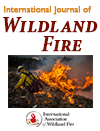International Journal of Wildland Fire
Volume 33
Number 8 2024
The intensification of Western US fire seasons has resulted in heightened competition for suppression resources as simultaneous incidents strain capacity. We present statistical models identifying characteristics (including region, fire weather, canopy cover, Wildland–Urban Interface category, and history of past fire) associated with ignitions which evolve to garner high personnel deployment.
This study creates a dataset of historical descriptions of Indigenous wildland burning from digitised historical texts in the eastern US. The current version of the dataset contains >250 descriptions in the northeastern US, mainly from 19th century historians. Descriptions correspond with geographic patterns in past fire-adapted vegetation.
This research used social science methods to investigate the influential factors on the translation of flexible wildfire policy governing natural ignitions into practice. We found that alignment of organisational capacity, collaborative management planning, and mechanisms to monitor and evaluate progress help facilitate successful reintroduction of wildfire to fire-adapted ecosystems.
We document how Uncrewed Aircraft System (UAS) technology was used in the 2020 Labour Day wildfires in Oregon, USA. Information from a literature review, social media, and interviews with disaster responders were compiled. Qalitative analyses on the interview data synthesised typical UAS applications and highlighted challenges.
We used airborne laser scanning (ALS) data and ground measurements to create fuel consumption maps for prescribed fires in central Utah. The data, methods, and accuracy assessments we produced are useful for researchers who collected data on fire behaviour, effects, and emissions on the same fires.
Fires ignited on Santa Ana Wind days are the largest and most destructive fires but other fires are more numerous and account for greater area burned. Fire indices on days after ignition are important predictors of fire size, but drought and wind speed are most closely tied to fire size.
The reimposition of an Indigenous fire regime (frequent, small, cool, early dry season fires) has the potential to sequester significant pyrogenic carbon in northern Australian savanna soils on decadal timescales. We observed an increase of 0.25 MgC ha−1 in transects with ≥5 fires over a 22-year period.
Savanna fire models rely on seasonal measures of available fine fuels. This study investigates monthly rates of fine fuel decomposition and accumulation in typical eucalypts-dominated savanna woodland in north Australia over an annual cycle. Whereas decomposition is shown to occur most rapidly in the wet season, accumulated fine fuels were greater late in the dry season.
This article belongs to the Collection Savanna Burning.
High-resolution satellite imagery is collected around various communities in Alberta, Canada. Machine learning algorithms are used to detect and classify individual trees from collected imagery in an automated fashion. Use of the algorithm in fuel mapping and community wildfire exposure assessments is explored.





